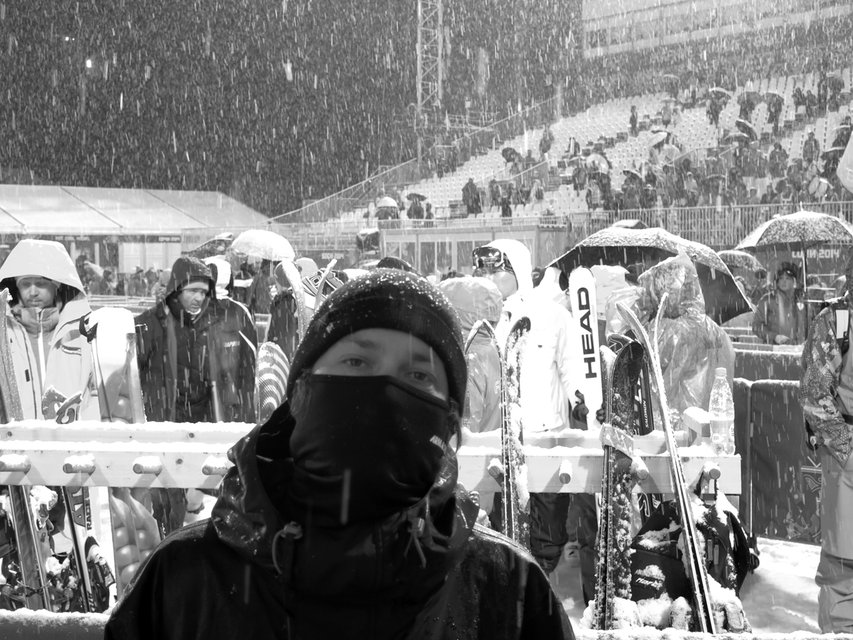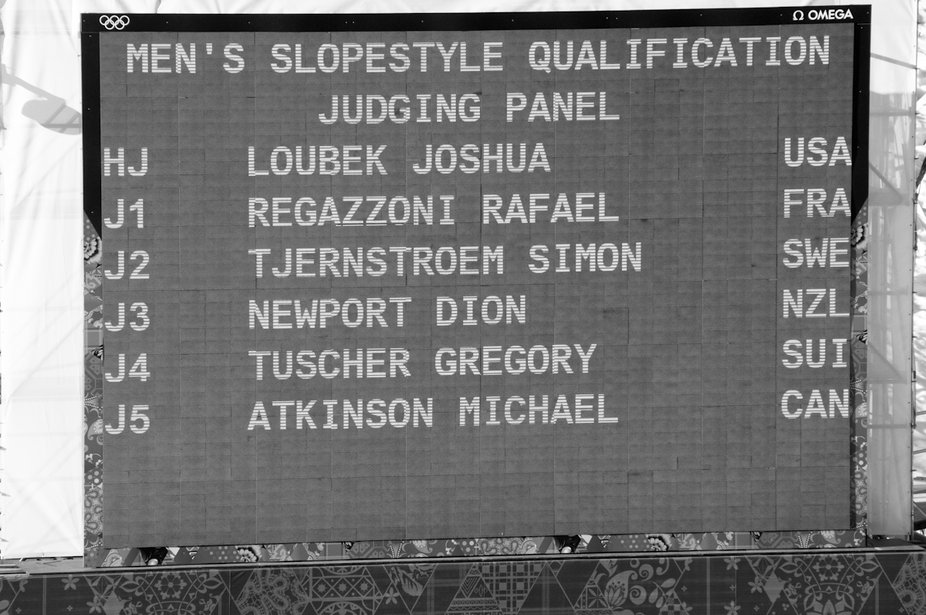Raf being a G at the bottom of the Olympic halfpipe in Sochi.
Photo: Mike Atkinson
Interview by Ethan Stone
“What’s up, man?
Nice to see you!”

Raf Regazzoni steps out of the hotel elevator and strides across the lobby to greet me.
And Raf, incongruous though he may appear, belongs right here with them.
He’s one of six officials here in Sochi to judge the skiing competition in halfpipe and slopestyle.

My cousin was a moguls rider and he got me into freestyle.
I got some photos in magazines in France, but I’ve never been really good.
I needed to learn English, so I moved abroad when I was 21 years old.

So I went there for a year and got my degree in international sport management.
A small ski company in my hometown, Zag Skis, asked me to work for them.
I took care of the sales stuff, some of the communications and the team riders.

That was when I got into the international side of skiing.
I met [AFP head judge] Josh Loubek over there.
Josh loved me the first time we met.

They wanted to find Euro guys who could do it.
We struggled a lot at the beginning.
It was hard to find someone that wanted to be involved and also had the time to do it.

But it was going there anyway, with or without us.
If we say no then they’re going to bring moguls guys in.
That was the case already before.
So we thought, let’s work together and venture to make our judging as good as we can.
We [the AFP judges] started with the FIS World Champs in Park City in 2011.
Then Simon and I did the final of the World Cup in La Plagne.
The head judge was the same guy that’s the head judge for moguls here in Sochi.
After the first night we figured out that these guys were just following our scores.
The head judge had no idea that you could adapt for the scores for the cut based on discussion.
It was nuts to see that happening, the final of the World Cup and bad calls with judging.
We didn’t want to be involved with those guys if they can’t make the calls.
How can we answer questions from the riders when we don’t know if the other judges know anything?
So let us decide who should be the judges."
On judging slopestyle
There’s a lot of discussion beforehand.
Here in Sochi we’ve been discussing a lot about the rails because there are so many options.
It’s not like halfpipe where there’s only one option.
So we have to discuss line choice, the combos, and all this stuff.
When it comes to style it’s really hard to discuss.
We had to figure out how to talk about style.
You’re never going to talk to a rider and say they didn’t have style.
It’s no respect to the guy in front of you.
The judges start comparing runs, and that’s where you start arguing.
We don’t always agree, and that’s why we have five scoring judges.
When it’s a tight discussion, we vote.
It’s majority judging.
Sometimes we have three against two, sometimes it’s four against one.
If the majority says the score should be higher or lower, then we adapt the scoring.
There’s a lot of arguing.
There are people in the booth like myself and Simon who have a strong voice.
We like to make our point.
On judges discussing in the booth
We are too young as a judged sport.
It’s a young sport that’s still progressing, and there’s new stuff coming up every time.
We saw that here.
A lot of things popped out, like Joss [Christensen] winning with a crazy run.
A switch right triple!
But I think we need that right now.
Sometimes the snowboard guys had a range between like a 78 and a 91.
That’s the difference between tenth place and the podium.
There should never be such a big a difference in the scores because it means that nobody agrees.
How you could explain the judging to the riders when you could’t agree in the booth?
Don’t get me wrong, we have differences in scoring as well.
But we give a shot to keep it to ten points.
That’s why we’re still discussing, so we don’t make those mistakes.
In the slopestyle event we only had two little issues.
We had Luca Tribondeau, the Austrian kid who didn’t make the cut for finals.
On paper, everything he did was insane.
The execution was the main thing with him in the end.
And then we had Henrik.
He was pissed off afterwards because a lot of media from Sweden were pushing him that way.
Everyone else understood that he [Henrik] had a hand drag.
He would have been on the podium without that.
But he had those mistakes compared with people who didn’t make any mistakes.
He didn’t have the cleanest run that he could have.
On the example that the Olympics set
It [slopestyle] is great on TV.
It’s great for mainstream media.
People are going to want to do it.
It’s about the example that you show to the kids.
What can we do?
That Finnish kid that did the switch double backflip japan, so sick!
You should have seen us yelling in the booth when we saw that.
But we’re not going to give the win to someone like that.
How much shit would we get for something like that?
It’s not our role to change the world.
It’s the riders' voices that we have to follow.
On Henrik Harlaut
He’s got Wu Tang shit right now.
That’s never happened to any sports guy before, which is insane when you think about it.
And how does he get it?
By being himself from the beginning.
He’s always been that kid with Wu Tang moves.
He has his style and he wants to show people what style is.
It’s been in my head for a long time.
I feel we have to create something right now and not let our sport go this direction with competitions.
The good side is using the Olympics exposure to help build something new.
It’s time for us to offer something different.
Not just to the riders that are here nowadays, but to the kids.
Show them what we are capable of.
Let’s get inspired from surfing and skateboarding and mix up different events and different formats.
The B & E Inventational and all these events, there’s something behind it.
The idea is to have a third BC event coming in 2016 as well as a potential fourth event.
Bring the legends, bring the comp guys and the film guys.
We can have fun and still have an event that’s appealing to the general public and TV audiences.